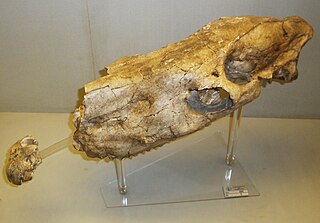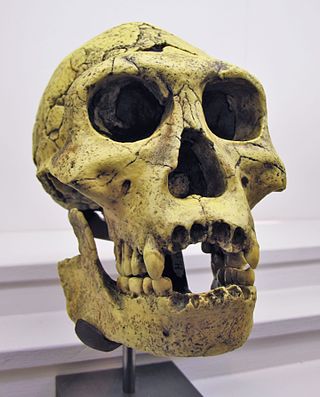
A mammoth is any species of the extinct elephantid genus Mammuthus. They lived from the late Miocene epoch into the Holocene until about 4,000 years ago, with mammoth species at various times inhabiting Africa, Asia, Europe, and North America. Mammoths are distinguished from living elephants by their spirally twisted tusks and in at least some later species, the development of numerous adaptions to living in cold environments, including a thick layer of fur.
Panthera is a genus within the family Felidae, and one of two extant genera in the subfamily Pantherinae. It contains the largest living members of the cat family. There are five living species: the jaguar, leopard, lion, snow leopard and tiger, as well as a number of extinct species, including the cave lion and American lion.

The Alpine ibex, also known as the steinbock, is a European species of goat that lives in the Alps. It is one of ten species in the genus Capra and its closest living relative is the Iberian ibex. The Alpine ibex is a sexually dimorphic species; males are larger and carry longer horns than females. Its coat is brownish-grey. Alpine ibexes tend to live in steep, rough terrain and open alpine meadows. They can be found at elevations as high as 3,300 m (10,800 ft) and their sharp hooves allow them to scale the steep slopes and cliffs of their mountainous habitat.

Dmanisi is a town and archaeological site in the Kvemo Kartli region of Georgia approximately 93 km southwest of the nation’s capital Tbilisi in the river valley of Mashavera. The hominin site is dated to 1.8 million years ago. It was the earliest known evidence of hominins outside Africa before stone tools dated to 2.1 million years were discovered in 2018 in Shangchen, China.

Gargano is a historical and geographical sub-region in the province of Foggia, Apulia, southeast Italy, consisting of a wide isolated mountain massif made of highland and several peaks and forming the backbone of the Gargano Promontory projecting into the Adriatic Sea, the "spur" on the Italian "boot".

Mammuthus meridionalis, sometimes called the southern mammoth, is an extinct species of mammoth native to Eurasia, including Europe, during the Early Pleistocene, living from around 2.5 million years ago to 800,000 years ago.
Araripesaurus is a genus a pterosaur belonging to the suborder Pterodactyloidea, it was discovered in the Romualdo Formation of the Santana Group in northeastern Brazil, which dates back to the Aptian and Albian of the Early Cretaceous. The type species is A. castilhoi.

Xenocyon is an extinct group of canids, either considered a distinct genus or a subgenus of Canis. The group includes Canis (Xenocyon) africanus, Canis (Xenocyon) antonii and Canis (Xenocyon) falconeri that gave rise to Canis (Xenocyon) lycanoides. The hypercarnivorous Xenocyon is thought to be closely related and possibly ancestral to modern dhole and the African wild dog, as well as the insular Sardinian dhole.

Pachystruthio is a genus of extinct bird which lived in Eurasia from the Late Pliocene to the Middle Pleistocene. Its fossils have been found in Hungary, Greece Crimea, Georgia, and China. The genus contains three species: P. pannonicus, P. dmanisensis, and P. transcaucasicus, which were all formerly placed with the ostrich genus, Struthio. An incomplete femur from the Nihewan Formation (China) has been assigned to Pachystruthio indet. P. dmanisensis has been estimated standing 4 meters tall and weighing up to 600 kg (990 lb), making it much larger than the modern ostrich and one of the largest known birds.

Stephanorhinus is an extinct genus of two-horned rhinoceros native to Eurasia and North Africa that lived during the Late Pliocene to Late Pleistocene. Species of Stephanorhinus were the predominant and often only species of rhinoceros in much of temperate Eurasia, especially Europe, for most of the Pleistocene. The last two species of Stephanorhinus – Merck's rhinoceros and the narrow-nosed rhinoceros – went extinct during the last glacial period.

Fallow deer is the common name for species of deer in the genus Dama of subfamily Cervinae.

Eurygnathohippus is an extinct genus of hipparionine horse. The majority of known fossils of members of this genus were discovered in Africa, where members of this genus lived during the late Miocene to Pleistocene interval. Fossils of Eurygnathohippus were also reported from the late Pliocene sediments of the Potwar Plateau in Pakistan and the Siwalik Hills in northwest India.

D2700, also known as Dmanisi skull 3, is one of five skulls discovered in Dmanisi, Georgia in 2001 and classified as early Homo erectus. It is an almost complete skull and is in an exceptionally good condition. It was dated stratigraphically as about 1.8 million years old.

Stephanorhinus kirchbergensis, also known as Merck's rhinoceros is an extinct species of rhinoceros belonging to the genus Stephanorhinus from the Early-Middle to Late Pleistocene of Eurasia. Its range spanned from Western Europe to Eastern Asia. Among the last members of the genus, it co-existed alongside Stephanorhinus hemitoechus in the western part of its range.

The Dmanisi skull, also known as Skull 5 or D4500, is one of five skulls discovered in Dmanisi, Georgia and classified as early Homo erectus. Described in a publication in October 2013, it is estimated to be about 1.8 million years old and is the most complete skull of a Pleistocene Homo species, and the first complete adult hominin skull of that degree of antiquity. According to researchers, the discovery "provides the first evidence that early Homo comprised adult individuals with small brains but body mass, stature and limb proportions reaching the lower range limit of modern variation." The skull has been the cause of a paleontological controversy that is still ongoing as of 2017: many hominin fossils thought to be from different species such as Homo rudolfensis or Homo habilis may not have been separate species at all. Rather, they may have been a single evolving lineage.

Several expansions of populations of archaic humans out of Africa and throughout Eurasia took place in the course of the Lower Paleolithic, and into the beginning Middle Paleolithic, between about 2.1 million and 0.2 million years ago (Ma). These expansions are collectively known as Out of Africa I, in contrast to the expansion of Homo sapiens (anatomically modern humans) into Eurasia, which may have begun shortly after 0.2 million years ago.

Canis etruscus, is an extinct species of canine that was endemic to Mediterranean Europe during the Early Pleistocene. The Etruscan wolf is described as a small wolf-like dog. It is widely agreed to be the ancestor of Canis mosbachensis, and thus ultimately the modern grey wolf.

Dali is a goddess from the mythology of the Georgian people of the Caucasus region. She is a hunting goddess who serves as the patron of hoofed wild mountain animals such as ibexes and deer. Hunters who obeyed her numerous taboos would be assured of success in the hunt; conversely, she would harshly punish any who violated them. She is most prominently attested in the stories of the Svan ethnic subgroup in northwestern Georgia. Other groups in western Georgia had similar figures considered equivalent to Dali, such as the Mingrelian goddess Tkashi-Mapa.

The Dmanisi hominins, Dmanisi people, or Dmanisi man were a population of Early Pleistocene hominins whose fossils have been recovered at Dmanisi, Georgia. The fossils and stone tools recovered at Dmanisi range in age from 1.85 to 1.77 million years old, making the Dmanisi hominins the earliest well-dated hominin fossils in Eurasia and the best preserved fossils of early Homo from a single site so early in time, though earlier fossils and artifacts have been found in Asia. Though their precise classification is controversial and disputed, the Dmanisi fossils are highly significant within research on early hominin migrations out of Africa. The Dmanisi hominins are known from over a hundred postcranial fossils and five famous well-preserved skulls, referred to as Dmanisi Skulls 1–5.
Equus altidens is an extinct species of equine native to western Eurasia including Europe during the Early Pleistocene to early Middle Pleistocene.
















